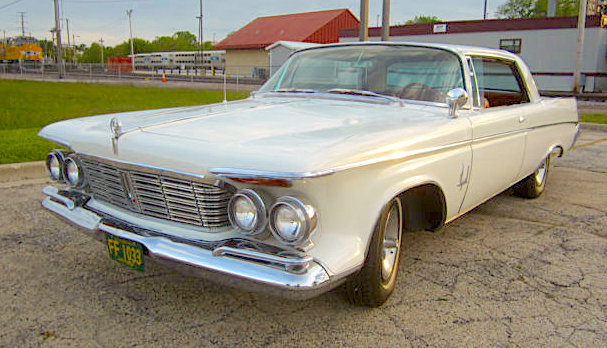During the 1950s, most American car brands got redesigned bodies every three or four years, relying on facelifts to freshen style during intermediate model years.
There were cases of more rapid body replacement. Wealthy (at the time) General Motors' 1958 Chevrolets and Pontiacs had a body for only that year. Chrysler Corporation cars got new bodies for 1955 and again for 1957, the '55s only having a two-year run. GM's Oldsmobiles, Buicks and Cadillacs had their new 1957 bodies replaced in 1959, another two-year example.
Companies with less financial strength often had to defer replacement for more than the average cycle length. For example, Studebaker sedan bodies were used from 1953 until the firm stopped making cars in 1966 -- that's 14 model years.
Another example is Chrysler's line-topping Imperial brand. All Chrysler's makes got new bodies for 1957. For the 1960 model year, all brands except Imperial were given new bodies featuring a form of unitized construction. I've yet to read an explanation for Imperial's exception, but I'll speculate that it had to do with wheelbase length and the task of modifying unit-bodies that was difficult compared to modification of body-on-frame cars. Chrysler New Yorkers had 126-inch wheelbases both before and after the changeover. Imperials had 129-inch wheelbases in 1959, but to have them share the new unitized bodies while maintaining the longer wheelbase would have been expensive for a brand that typically sold fewer than 20,000 cars per year. In other words, it was cheaper to continue the body-on-frame arrangement, especially because Imperials were already being assembled at their own factory -- a facility formerly used by Graham and DeSoto -- and therefore didn't need to be integrated into assembly lines for other Chrysler products.
This arrangement continued through the 1966 model year. Thereafter, Imperials were again derivations of Chryslers until the brand was phased out after 1975.
Wikipedia's Imperial
entry refers to 1957-1966 models as the brand's "second generation," so scroll down the link for its take on those Imperials.
The present post presents images of Imperials as seen in profile, later ones deal with frontal and aft facelift details. What I find interesting is how extensive those facelifts became over time.
Unless otherwise noted, the images below are of cars posted for sale on various web sites.
Gallery
1957 Imperial Crown Southampton Coupe
In order to keep a reasonable length for this post, year-to-year comparisons are for four-door hardtop sedans. However, let's first compare Imperial hardtop coupes for the first and final models years using the same basic body.
1966 Imperial Crown Coupe, Earlywine Auctions photo
A lot changed over those ten model years. What is consistent in these two photos is the 129-inch wheelbase along with the windshield, its wing vent, and the door's position.
* * * * *
1957 Imperial Crown Southampton Sedan
This is the starting point's styling.
1958 Imperial Crown Southampton Sedan
The car in this photo has droopy rear suspension, so ignore the tilt. Seen from the side, there are no obvious changes: those mostly are on the car's face.
1959 Imperial LeBaron Southampton Sedan
Again, the sides of Imperials are are essentially unchanged, even on this line-topping LeBaron.
1960 Imperial LeBaron Southampton Sedan
Other Chrysler Corporation cars got new bodies for 1960, whereas Imperials received a major facelift. All Imperials' tailfins were restyled in an appalling manner. LeBarons had back windows reduced in size, creating more privacy for rear-seat passengers. This continued for the two following model years.
1961 Imperial Crown Southampton Sedan
Most Imperials were of the Crown variety. Back windows were reshaped for the 1960 facelift. Headlights were became retro, free-standing affairs harking to 1930s styles, as can be glimpsed here. Tail lights were separated from the tailfins.
1962 Imperial Crown Southampton Sedan
The major change for 1962 was the elimination of tailfins, though restyled tail light assemblies remained detached.
1963 Imperial Crown Southampton Sedan
Elwood Engel, who replaced Virgil Exner as Chrysler's styling director in 1961, made his mark with the classic 1961 Lincoln Continental. When development lead times permitted, he slowly nudged Imperial styling in that more angular direction. Here we find a wider C-pillar and the integration of tail lights into the rear fenders.
1964 Imperial Crown hardtop sedan
Now Imperials assume even more Lincoln Continental characteristics. The aft part of the passenger greenhouse is further squared off. Those detached headlights have been moved into the grille ensemble and the front fender is reshaped accordingly. A character crease is added to the rear fender side. Continental chrome strips are atop the fender line. For the first time, the rear door shapes have changed: compare their cut-lines with those in pervious photos.
1965 Imperial Crown hardtop sedan
No significant side changes for 1965.
1966 Imperial Crown hardtop sedan
The final year for the 1957 body. Again, nothing new in the side view: visible differences are found on the grille design. Compared to the '57, this seems like a totally different car. The most noticeable similarity is the windshield.
























































